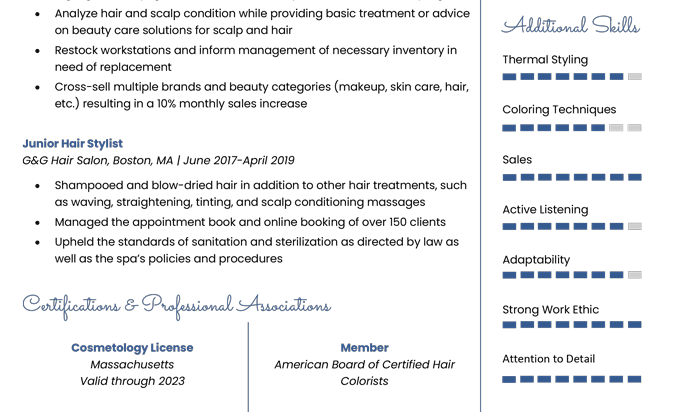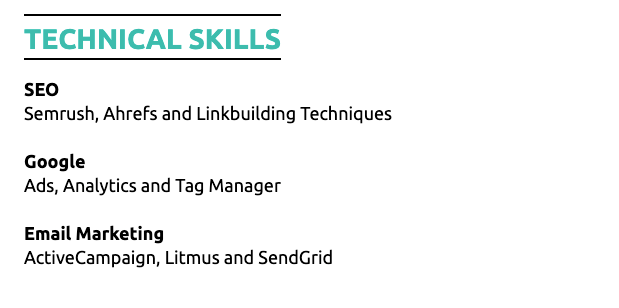When crafting a resume, it’s essential to effectively showcase your skills, as they play a crucial role in impressing hiring managers and landing your dream job.
In this article, we will explore the importance of the skill section in resumes. We will also look into best practices for where to put skills on a resume and how to make your skills section stand out.
Importance of Skills on a Resume
Before delving into the specifics, let’s understand why showcase skills on a resume is vital. Your skills demonstrate your qualifications, expertise, and ability to contribute to a potential employer’s objectives. They provide valuable insights into your capabilities and differentiate you from other candidates. Therefore, strategically placing and highlighting your skills on a resume is key to grabbing the attention of hiring managers.
Here is the Skill Section

Placement of Skills
The skills section usually appears after the professional summary or objective statement. Placing it early in your resume allows recruiters to quickly identify your core competencies. You can position it either as a separate section titled “Skills” or incorporate it within relevant section, such as “Core Competencies” or “Key Skills.” The important thing is to ensure that your skills section is prominently displayed and easily accessible.
Relevant Skills
When deciding which skills to include, focus on those that directly relate to the job you’re applying for. Tailor your skills to match the specific requirements mentioned in the job description. This will demonstrate your suitability for the role and increase your chances of getting noticed. For example, if the job requires strong leadership skills, emphasize your experience in leading teams or projects.
Transferable Skills
In addition to relevant skills, don’t overlook transferable skills. These are abilities that can be applied across various industries or roles. Transferable skills, such as communication, problem-solving, and adaptability, are highly valued by employers. Include them in your skills section to showcase your versatility and flexibility.
Technical Skills
For positions that require specific technical expertise, it’s crucial to highlight your proficiency in relevant tools, software, programming languages, or specialized knowledge. List these technical skills in a separate subsection within your skills section to draw attention to your technical competencies.
Aligning Skills to Employer Needs

Analyzing Job Requirements
To effectively tailor your skills to the job description, start by carefully analyzing the requirements outlined in the job posting. Pay close attention to the desired qualifications, preferred experience, and specific skills mentioned. This analysis will help you identify the key skills that the employer is seeking.
Matching Skills to Job Description
Once you have identified the desired skills, match them to your own skill set. Review your experiences, education, and training to find examples that demonstrate your proficiency in those areas. Be specific and provide quantifiable results or achievements whenever possible. This will make your skills more impactful and memorable to potential employers.
Showcasing Skills Effectively

Using Action Verbs
When describing your skills in your resume, use strong action verbs to create an engaging and dynamic representation of your abilities. Instead of simply listing skills, use phrases like “developed effective communication skills” or “led a team to achieve project goals.” This not only adds depth to our resume writing service but also conveys a sense of proactive involvement in your previous roles.
Quantifying Skills
To further enhance the impact of your skills, quantify them whenever feasible. Numbers, percentages, or specific achievements help provide tangible evidence of your capabilities. For instance, instead of saying “strong sales skills,” you could state “increased sales by 20% through strategic marketing campaigns.” Quantifying your skills gives potential employers a clear understanding of your accomplishments.
Highlighting Accomplishments
Incorporate your skills into your work experience section by showcasing how you applied them to achieve notable results. Describe specific projects, initiatives, or challenges you successfully tackled using your skills. This demonstrates your ability to apply your skills in real-world scenarios and adds credibility to your resume.
Additional Tips for Skills Section
Keep the skills section concise and relevant. Include the most important skills and avoid overcrowding your resume with unnecessary details.
Prioritize skills that align with the job requirements and the industry you’re targeting.

Regularly update your skills section to reflect any new certifications, training programs, or professional development courses you have completed.
Use bullet points to make your skills section easily scannable for recruiters who may be quickly reviewing resumes.
Tailor your skills section for each application, emphasizing the most relevant skills based on the job description.
The Bottom Line Is!
The placement of skills on a resume can significantly impact how effectively you present yourself to potential employers. By strategically placing your skills section and tailoring it to match




